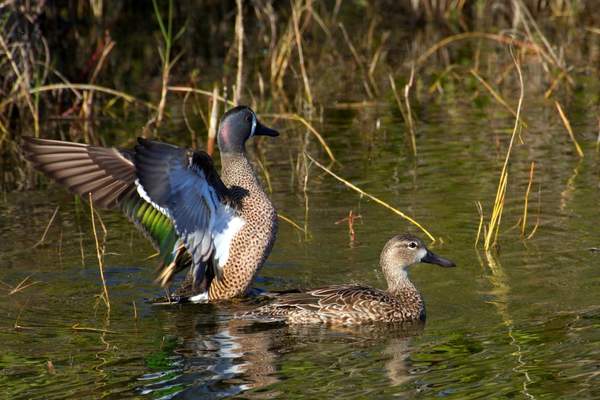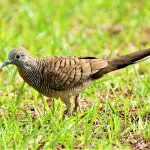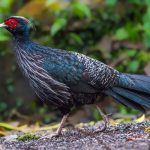Common Name: Blue-winged Teal
Scientific Name: Spatula discors| Size | Diet | Range in Hawaii | Status in Hawaii |
|---|---|---|---|
| 15 in. - 17 in. | insects and aquatic invertebrates | Oahu, Kauai, and the Big Island | Least Concern |
The blue-winged teal (Spatula discors) is a small species of dabbling duck that is native to North America. It is named for the distinctive blue patches on its wings, which are visible when the bird is in flight. It is a popular game bird, and it is also an important species for wetland conservation.
Blue-winged teal
Appearance

The blue-winged teal has a compact, streamlined body and a relatively short neck and bill. The adult male has a dark brown head, a white neck ring, and a reddish-brown breast. The back and wings are mottled brown, and the wings have a distinctive blue patch that is visible when the bird is in flight.
The adult female has a similar appearance, but she is generally duller in color and has a less distinct neck ring. The female also has a more horizontal stance, while the male has a more upright stance. Juvenile blue-winged teals resemble the adult female, but they are generally even duller in color.
In general, adult blue-winged teals are small ducks that measure about 15-17 inches in length and have a wingspan of about 22-25 inches. Male blue-winged teals tend to be slightly larger than females, but the size difference is not particularly noticeable.
Diet
The blue-winged teal is a omnivorous species and its diet can vary depending on the availability of food and the time of year. In the summer breeding season, blue-winged teals feed on a variety of insects, such as beetles, grasshoppers, and flies, as well as aquatic invertebrates, such as snails and worms.
They also feed on seeds, grains, and other plant material. During the winter, their diet shifts to more plant material, including seeds, grains, and aquatic plants.
Behavior
Blue-winged teal are small, migratory dabbling ducks that are native to North America. They are known for their rapid wingbeats and agile flight, and can often be seen flying low over the water in tight flocks. During the breeding season, males establish and defend territories, and engage in elaborate courtship displays to attract females.
These displays include vocalizations, head nodding, and wing and tail feather displays. During the non-breeding season, blue-winged teal form large flocks and can be found in a variety of wetland habitats. Blue-winged teal are generally not aggressive towards humans, and can often be observed fairly closely.
Nesting
During the breeding season, female blue-winged teal build nests in a variety of locations, including grassy areas near water, marshes, and wet meadows. They construct their nests by using grasses, feathers, and other materials to create a shallow depression in the ground, which they line with down and feathers.
Female blue-winged teal typically lay a clutch of 7-12 eggs, which they incubate for about 21-23 days. Both male and female blue-winged teal participate in incubation, with the female doing the majority of the incubating during the day and the male taking over at night. Once the eggs hatch, the female leads the ducklings to water, where they feed on insects and other small invertebrates.
The male typically stays nearby to protect the family from predators. The ducklings grow quickly and fledge (leave the nest) after about 45-50 days. After fledging, the young blue-winged teal continue to be dependent on their parents for several more weeks before becoming independent.
Habitat

Blue-winged teal are typically found in wetland habitats, including marshes, ponds, lakes, and rivers. They require shallow water and a variety of aquatic plants and invertebrates for food. During the non-breeding season, they may also be found in agricultural fields, particularly in areas where grain has been recently harvested.
Range
According to eBird, blue-winged teal have been have been recorded in Hawaii and observed on several of the main Hawaiian islands, including Oahu, Kauai, and the Big Island, although they are still considered to be rare and irregular visitors to the islands.
Hawaii
Conservation Status
According to the IUCN Red List, the blue-winged teal is classified as “Least Concern” globally. This means that it is not currently at risk of extinction and is considered to have a stable population.
Interesting Facts
1. First duck species to migrate south in the fall
They are one of the first duck species to migrate south in the fall, and they can often be seen flying in large flocks at this time of year.
2. They have webbed feet
Blue-winged teals have webbed feet. The webbing on a blue-winged teal’s feet extends almost to the end of the toes, and is typically dark in color.
3. They eat small fish
Blue-winged teals consume a variety of other types of food, including small invertebrates such as snails, worms, and leeches, as well as small fish, crustaceans, and other aquatic animals.
4. They migrate at night
Many species of waterfowl, including blue-winged teals, migrate at night. Migrating at night allows birds to take advantage of cooler temperatures, which can make it easier for them to fly long distances. It also allows them to avoid predators, as many birds of prey are active during the day
Frequently Asked Questions
How fast is a blue-winged teal?
According to the Cornell Lab of Ornithology, the average flight speed of a duck is about 25-30 mph (40-50 km/h). This can vary depending on the species, size, and physical condition of the individual bird, as well as the wind and other environmental conditions.
How big is a blue wing teal?
Blue-winged teals are small ducks, with a body length of about 14-16 inches (35-41 cm) and a wingspan of about 20-22 inches (51-56 cm). Males are slightly larger than females, with males weighing an average of about 300 grams (10.6 ounces) and females weighing about 250 grams (8.8 ounces).
How long do blue-winged teals live?
Blue-winged teal have a lifespan of about 2-3 years on average. However, it is not uncommon for some individuals to live longer, with a maximum lifespan of about 8-10 years recorded in the wild.




